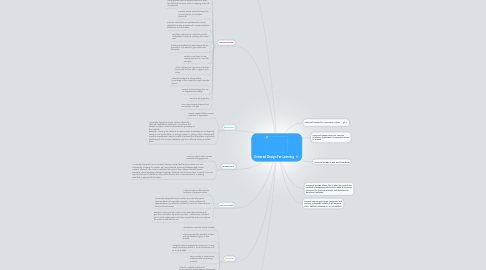Universal Design For Learning
by Christine Nordal

1. Who Benefits:
1.1. Students who speak English as a second language
1.2. International students
1.3. Older students
1.4. Students with disabilities
1.5. A teacher whose teaching style is inconsistent with the student’s preferred learning style
1.6. All students!
2. Principles:
2.1. Identify the essential course content
2.2. Clearly express the essential content and any feedback given to the student
2.3. Integrate natural supports for learning (i.e. using resources already found in the environment such as study buddy)
2.4. Use a variety of instructional methods when presenting material
2.5. Allow for multiple methods of demonstrating understanding of essential course content
2.6. Use technology to increase accessibility
2.7. Invite students to meet/contact the course instructor with any questions/concerns
3. Representation:
3.1. Course content offers various methods of Representation
3.2. Universally designed course content provides alternative representations of essential concepts. Various methods of representation can allow the student to learn the information in their preferred means
3.3. Example: Placing course notes on the web allows students to gain the information by lecture and text. Additionally, a student with a visual impairment could tape record the lecture to capture the notes in alternate format
4. Engagement:
4.1. Course content offers various methods of Engagement
4.2. Universally designed course content maintains varied skill levels, preferences, and interests by allowing for options. By having flexible teaching strategies and course content, students can choose methods that support their interest and skill levels. Example: When teaching a foreign language, students could choose from a variety of on-line options that would allow them to practice fluency and comprehension at a reading level that is appropriate for them.
5. Expression:
5.1. Course content offers various methods of Expression
5.2. Universally designed course content allows for alternate methods of expression. This allows the student multiple means of demonstrating mastery of the material. Example: Allowing the students to demonstrate knowledge on a subject by doing an oral presentation or writing a paper or taking a test. Students with a speech impediment may be unable to present the information orally while students with a fine motor disability may have difficulty taking a written exam
6. Implementation:
6.1. Put course content on-line allowing students to “pick up” material that might have been missed in lecture
6.2. Use peer mentoring, group discussions, and cooperative learning situations rather than strictly lecture
6.3. Using guided notes enables students to listen for essential concepts without copying notes off of overhead
6.4. Update course materials based on current events and student demands
6.5. Provide comprehensive syllabus with clearly identified course requirements, accommodation statement and due dates
6.6. Fluctuate instructional methods, provide illustrations, handouts, auditory and visual aids
6.7. Clarify any feedback or instructions, ask for questions, and repeat or give additional examples
6.8. Relate a new topic to one already learned or a real-life example
6.9. Allow a student to tape record lectures or provide him/her with a copy of your notes
6.10. Allow the student to demonstrate knowledge of the subject through alternate means
6.11. Permit and encourage the use of adaptive technology
6.12. Develop study guides
6.13. Give more frequent exams that are shorter in length
7. Resources:
7.1. Universal Design. Available: http://www.cast.org
7.2. Curriculum Transformation and Disability. Funded by the US Department of Education. Project #P333A990015. Ways to Incorporate Universal Instructional Design. Common Teaching Methods. Available here
7.3. Do-It. University of Washington. Funded by the National Science Foundation, The US Department of Education, and the State of Washington. Grant # 9725110. Available: http://www.washinton.edu/doit/
7.4. University of Arkansas at Little Rock. College of Education. Available: www.ualr.edu/~coedept/curlinks/sped.html
7.5. http://erlc.wikispaces.com/Alberta+UDL+Summer+Institute+-+Making+Connections
8. Universal Design for Learning in Action
9. Designs course instruction, materials, and content to benefit people of all learning styles without adaptations or retrofitting
10. Universal Design allows the student to control the method of accessing information while the teacher monitors the learning process and initiates any beneficial methods
11. Universal Design does not remove academic challenges; it removes barriers to access
12. Universal Design is just good teaching!


